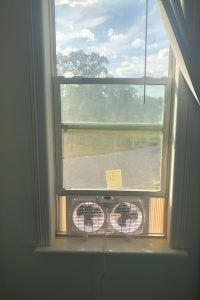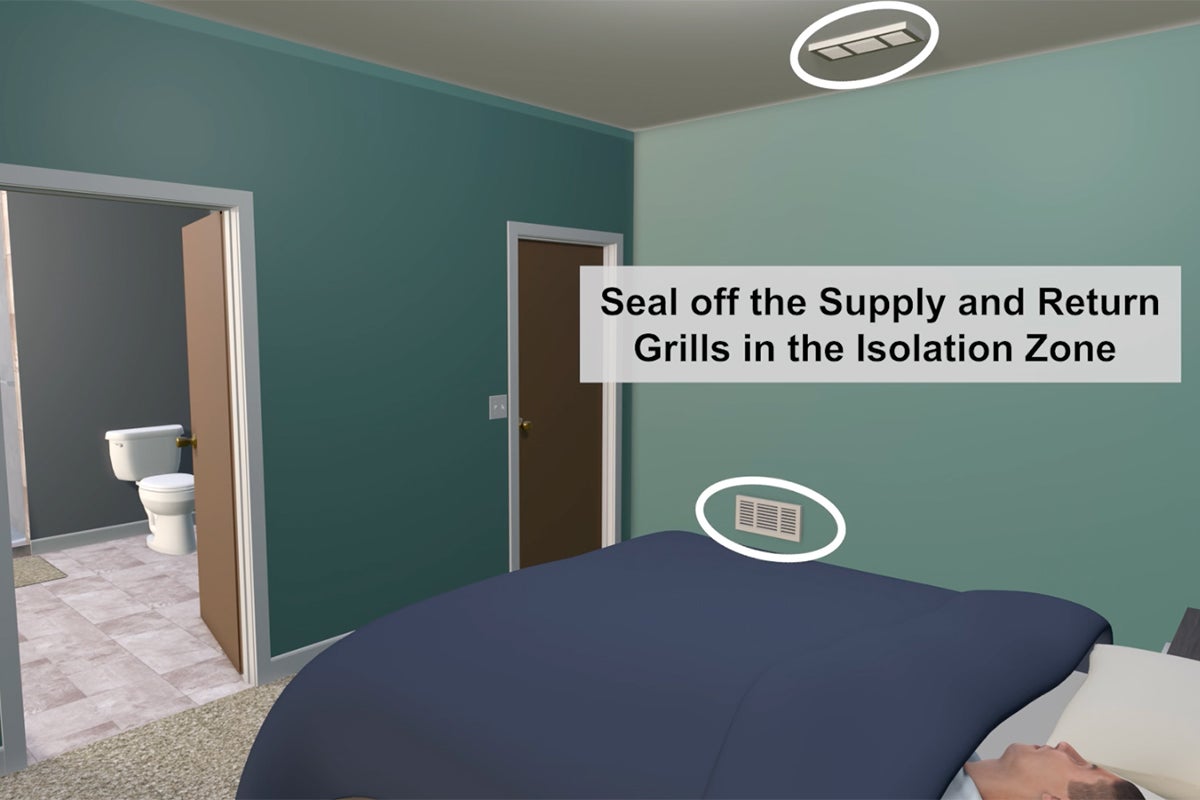Your home may be the most comfortable place to be during an epidemic, until someone’s infected. If someone in your household gets COVID-19 or another airborne disease, how can you prevent it from spreading to others in your home? This question is the basis of a recently completed research project at the FSEC Energy Research Center, a research institute at the University of Central Florida.
Using a full-scale laboratory home, UCF researchers evaluated methods to create an isolation zone in a single-family home where an infected person could remain separated from the rest of the occupants. The researchers found that a basic isolation zone for a contagious person could be created with little cost and effort.
They will present their findings in an upcoming webinar on Thursday, Aug. 12 at 3 p.m. EST.
FSEC’s Buildings Research Division has been investigating energy, moisture and airflow dynamics in buildings since 1980. Researchers pitched the idea to the National Renewable Energy Laboratory (NREL). The U.S. Department of Energy provided the funding for the study, while NREL provided oversight.
The idea for the research project originated from the need to solve a problem many people have recently faced.
“After reading a story about the efforts a wife and child were making to stay healthy while caring for an infected husband in their home, we felt we might be able to help these situations by applying what we know about how air moves in homes,” says Danny Parker, a principal research scientist at the FSEC Energy Research Center. “The risks of airborne COVID-19 transmission are much greater indoors than outdoors, and the need for a means of control was great.”
Infectious diseases transmitted via aerosols, such as COVID-19, can be a challenge to prevent from spreading indoors.
Increasing ventilation rates and installing high efficiency filters may help mitigate the risk of airborne transmission, but not many people are likely to have the time or means to implement these sorts of advanced control measures in their homes.
However, researchers thought it would be possible to create a negative-pressure isolation room, similar to what is commonly used in hospitals.

“Hospitals use depressurized rooms to isolate persons with a suspected or confirmed airborne infectious disease, so we wanted to see if we could achieve a similar environment within a single-family home,” says Eric Martin, a program director and the principal investigator of the study. “We focused on utilizing existing or easy-to-acquire materials and simple processes. Of course, the isolated infected person may need to be tended to during their illness, and best practice includes personal protective equipment by anyone entering the isolation space.”
Creating an isolation space is one of the recent guidelines for COVID-19 risk reduction in residential buildings established by ASHRAE, a global professional society of over 55,000 members, committed to serve humanity by advancing the arts and sciences of heating, ventilation, air conditioning, refrigeration and their allied fields. ASHRAE’s recommendations came from a task force it created to respond to the current global COVID-19 pandemic and prepare for future ones.
In order to create an isolation space, the air pressure in the space must be kept lower than the rest of the house. Using a full-scale laboratory home, researchers tested 17 different configurations that were designed based on various heating, ventilating, and air-conditioning (HVAC) operating scenarios, intervention measures, and the use of exhaust or window fans for pressure control.
The method the UCF researchers determined for creating an easy, cost-effective basic isolation zone for a contagious person is outlined below.
What They Found
A bedroom with a door separating it from the rest of the house could be used as a basic isolation zone. An ideal isolation zone would be a bedroom with an attached bathroom that has an exhaust fan capable of running continuously so that it pulls contaminated air out of the isolation zone.
The necessary steps to achieve an adequate pressure difference and minimize the transfer of infectious aerosols to other parts of the home include: closing all windows in the house, closing the door between the isolation zone and the rest of the house, sealing the air supply and return air grilles in the isolation zone, and turning on a bath exhaust fan at its highest speed setting—or in combination with a window fan installed as an exhaust fan in one of the bedroom windows.

“The key is to create adequate negative pressure in the isolation zone compared to the main area of the house,” says Tanvir Khan, co-investigator and postdoctoral building science researcher at the FSEC Energy Research Center.
“We also tested an inexpensive, portable window fan to use instead of, and in addition to, a built-in bath exhaust fan. The window fan helped extract air from the isolation zone and achieved the target depressurization,” he says. “Opening windows to try and achieve adequate depressurization is unpredictable because containment would be intermittent, depending upon wind speed and direction.”
Since most households don’t have access to specialized equipment to measure pressure across rooms, a simplistic “tissue test” method can be used instead, the researchers say.
“While holding up a piece of tissue next to the undercut of the door outside the isolation zone, the goal is to get the tissue sucked into the opening, then adequate depressurization in the isolation zone is achieved,” Khan says.
Sealing off isolation zone supply and return grilles was necessary to attain the target containment pressure, and also to prevent infectious aerosols from spreading through ductwork, the researchers say.

“Sealing off the grilles may result in uncomfortable conditions for the isolated person,” says Charles Withers, a co-investigator of the study and building science researcher at FSEC Energy Research Center. “But a room space heater or room air conditioner may be used to address any comfort issues, which could cost $75 and $300 to $600, respectively.”
It’s important to note that these containment strategies are expected to be used for a short-term period of less than a month, the researchers say. Situations requiring longer-term containment should ensure that potential moisture-related durability concerns are minimized.
The researchers say concerns may arise when outdoor dew points are high (exceeding 72°F) and infiltration of the humid air that results from space depressurization occurs over the long-term. They recommend that the isolation room temperature be maintained above the outdoor air dew point. This will help avoid the potential for condensation that could result in mold and durability issues, which is especially important in homes with vapor-impermeable wall or floor coverings, such as vinyl wallpaper.
To learn more about the research, register for the upcoming webinar. The webinar, titled Approaches for Effective Isolation Space Control to Minimize Airborne Transmission of Contaminants in Residential Homes, will be hosted by the Energy & Environmental Building Alliance and presented by Khan.
A video showing the ideal isolation method is available at: https://vimeo.com/557714520

The research results are published at:
Fact sheet: https://www.nrel.gov/docs/fy21osti/79519.pdf
Full report: https://www.nrel.gov/docs/fy21osti/79516.pdf
UCF researchers also conducted a separate, in parallel study with four containment controls in an occupied single-family home under various operating conditions.
Journal article: https://www.mdpi.com/1660-4601/18/11/5880
About the Researchers
UCF researchers involved with the study have extensive experience in building science. Principal Investigator Eric Martin earned his master’s degree in environmental engineering from Florida Institute of Technology in 1996 and has more than 25 years of experience in energy and buildings research at UCF’s FSEC. His current research focuses on space conditioning, ventilation, and indoor air quality solutions for high performance homes.
Co-investigator Tanvir Khan earned his doctorate degree in environmental engineering from Michigan Technological University in 2018. He specializes in ambient and indoor air quality measurement and modeling. Khan is focusing on indoor air quality control measures, such as whole house mechanical ventilation, in his postdoctoral research at UCF.
Co-investigator Charles Withers earned a Bachelor of Science in secondary education physics at Slippery Rock University of Pennsylvania and has more than 30 years of experience in buildings energy and indoor environmental research at UCF. Withers is also an instructor of building science-related courses at FSEC where he transfers his research findings to building professionals.
Research associate Danny Parker earned a Master of Science in environmental science from the University of Montana. Parker has 33 years of experience in buildings research at UCF. He specializes in collecting and analyzing measured data taken from residential and commercial buildings to determine how results may be applied to reducing energy needs. He holds several patents associated with innovative energy efficiency technologies, including UCF’s most productive patent, the Gossamer Wind ceiling fan.




